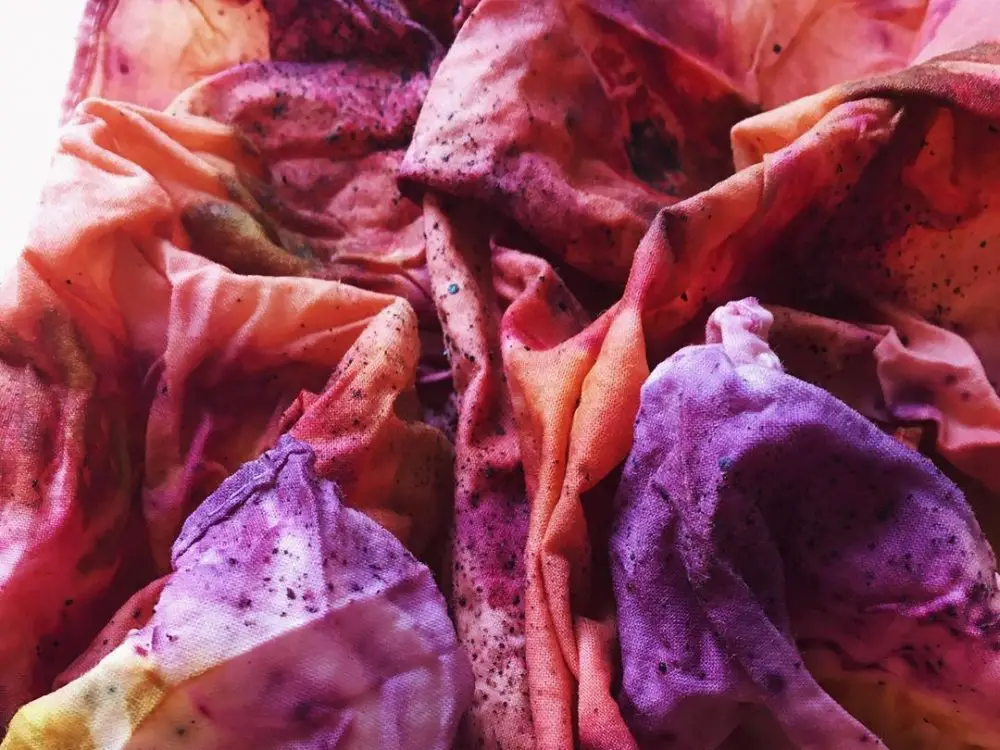Natural dyeing has become all the rage as environmentalists and creatives alike look for ways to reconnect with their surroundings. As soon as you open social media and search “natural dyeing,” you’re inundated with a plethora of color, plants and nature. On Instagram, the hashtag #naturaldyes has over 298,000 posts, and #naturaldyeing has over 173,000; it’s clear that natural fabric dyeing is a growing trend to get behind.
Not only is natural dyeing environmentally friendly, but it’s also a creative process that allows your inner-artist and inner-innovator to shine. By dyeing your own fabrics, yarn and clothes, you’re bucking the consumerist lifestyle, you’re sustainably reusing what’s around you and you’re saving the planet.
Rebecca Desnos (@rebeccadesnos) was my first glimpse into the world of natural dyeing. Desnos has a multitude of Instagram stories, tips, and creative ideas that will get anyone interested in the natural dyeing movement. For a comprehensive collection with tips and tricks, check out her Plant Dye Zine, or her book, “Botanical Colour at your Fingertips,” which is also available as an eBook.
Desnos is an accomplished and practiced natural dyer who has inspired thousands to join the sustainable trend, acting as a sort of natural dyeing messiah, as she paves the way for thousands to join the movement.
What Is Natural Dying?
So, let’s talk about the logistics of natural dyeing. What does the whole process entail? How do you get the color to stick to your chosen fabric? And what plants and foods result in the best color for your fabrics? First, you must choose which material you wish to dye.
The options are seemingly endless, but whether you choose cotton, linen, hemp, bamboo viscose, beads or yarn, the process is more or less the same. All of the aforementioned materials are vegan, but it’s also possible to dye animal fibers (namely, wool and silk) if you so choose.
Before you get to the fun part — watching the color form as you simmer your plants and foods — it’s crucial to consider the role of mordants. Mordants are a substance that combine with a dye or stain and fix it to a material, allowing the color to stick as the cellulose fibers bond with the plant dyes.
The most environmentally friendly mordant (and my personal favorite) is soya (soy milk). However, if you’re averse to soya, you have other options, including ammonia, vinegar, salt, baking soda, iron and cream of tartar. Soaking your chosen material in this mordant for several hours (or ideally, one full day) will allow the color to truly pop.
If your goal is to achieve a very subtle color, then skip the mordant step and jump right to natural dyeing. But be careful — after a few washes, the color will begin to fade if you choose to skip the mordant.
How To Choose Your Dye
Now comes my favorite part — choosing the natural dyes. For light pink and earthy tones, dried avocado skins along with their stones and pomegranate seeds are your best options. If you are more intrigued by orange and autumnal hues, then beetroot and yellow and red onion skins will deliver these fall shades with grace.
If you’re like me and obsessed with all things yellow, dandelions, pomegranate skins and turmeric will give you an abundance of sunny tones. Green dyes are best achieved with a variety of green plants, such as spinach and green lettuce.
Shades of blue can be achieved with, unsurprisingly, blueberries, but also black beans. Subtle greys are best achieved with the nettles plant and blackberries. Purples are attainable through the lovely rosemary spice, and with red cabbage. For warm tan and brown earth-hues, alder cones, walnut leaves, avocado skins (without their stones) and acorns are best.
How To Naturally Dye Your Material
Next up is simmering your chosen materials in a pot over the stove. Gently put your chosen foods or plants into a pot and cover your colorants with lots of water. If you want a richer color, put just enough to cover your colorants. It’s essential that your pot is only gently simmering; you don’t want too much movement to affect your color. Make sure to carefully stir your materials every few minutes to ensure an equal coating on all sides.
Timing varies, but approximately 30 minutes is usually enough to result in a rich color. Like anything, timing will vary depending on the hue you are attempting to cultivate.
If you wish to slightly alter the colors of your dyed materials, changing the pH of the dye, using iron or even rust water are all viable options to expand your color palette and get a darker color. Ultimately, your color palette is unlimited. The process of natural dyeing lies in creativity and experimentation, so perfecting your idealized fabric color will take trial and error and a lot of patience.
It’s also important to understand that just like people, plants are all very different. Not all avocados will result in the same hue because they are coming from all over the world and have experienced different altitudes, temperatures, humidity levels and many other factors.
Natural dyeing is a process, but its intricacies only make it more enjoyable. Oftentimes, hobbies that take quite a bit of time to perfect end up becoming our favorites, as they truly allow us to bend and twist our minds in ways that they’re not used to.
Natural dyeing is special in this way. Although it will take hours of dedication and alterations, the reward of creating the exact color you had in mind is gratifying. It is also an overtly creative hobby that unites artistry, creativity, experimentation, sustainability and fashion, which is likely why it has become so popular.
Natural dyeing is also a small way to positively impact our ever-changing planet. Natural dyeing is a way to avoid fast fashion, unethical production, animal testing and our consumerist tendencies. By collecting foods, plants and materials to dye with, you’re reusing materials that otherwise would have gone to waste and making them into something incredible. Not only is natural dyeing a fun, creative hobby, but it’s also a way to intimately reconnect with your surroundings and your planet for a sustainable future that we can all be proud of.

















